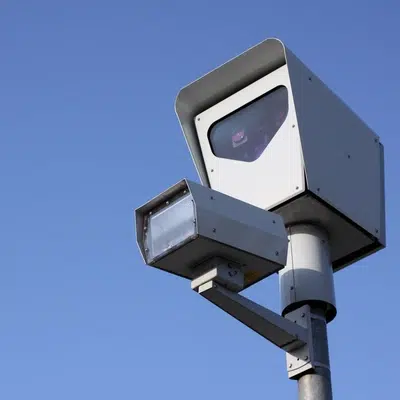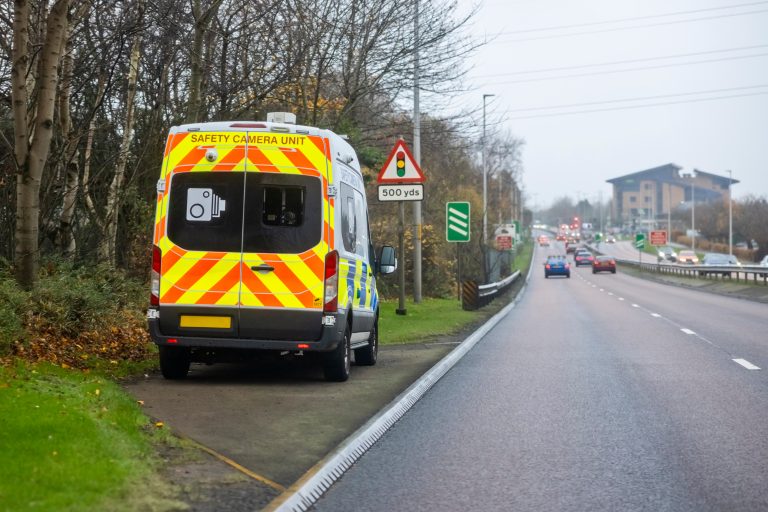Mobile speed cameras help control dangerous driving on the roads by detecting and recording the speed of motorists.
According to a 2017 study by the London School of Economics and Political Science, speed cameras helped to reduce accidents by 17 to 39% and fatalities by 58 to 68% over a 25-year period. They’re an effective safety measure and, as a result, you’re likely to encounter them on the road fairly regularly.
As a driver, knowing how portable speed cameras work is essential to keeping the authorities, other road users, and your wallet happy.
Let’s dive in.
- What is a mobile speed camera?
- How do mobile speed cameras work?
- Do mobile speed camera vans take a picture of the driver?
- What is the speed tolerance for mobile speed cameras?
- What happens if you get caught by a mobile speed camera?
- Summary
What is a mobile speed camera?

Also known as a safety camera, a mobile speed camera is a portable device that judges and records a vehicle’s speed. Many safety cameras can also record other kinds of reckless driving, such as driving while texting or tailgating.
Mobile speed cameras are often housed in police vans that are parked on the side of the road. They also come in the form of handheld devices used by patrolling officers.
It’s important to note that, in the UK, mobile speed camera vans are not legally required to be visible, so it’s important to be vigilant about following the speed limit at all times.
How do mobile speed cameras work?
Mobile speed cameras can catch speeding drivers up to a mile away, regardless of the direction they’re travelling in. They offer a useful alternative to average speed cameras, which are set up at two fixed points along the road and record your average speed between these two locations.
Mobile speed cameras work through radar or laser technology.
Radar technology
Radar technology detects a vehicle’s speed using radio waves that are fired at its target. If the radar device detects excessive speed, it will tell the camera to take a picture.
Radar-based speed traps work on something called the Doppler shift — the effect of the frequency of a wave changing in relation to how close it is to the person observing it. (An example of the Doppler shift that you may be familiar with is when the siren of a fast-moving ambulance drops in pitch as it passes you.)
Because the Doppler shift is observed in moving things, it can be used to determine an object’s speed, and, as such, is a valuable tool for law enforcement.
AECOM mobile speed cameras have recently been introduced on UK roads to catch numerous driving offences, including driving while using your mobile phone and not wearing a seatbelt.
This type of speed camera can be installed onto a police van and uses infrared technology to take multiple high-definition photos of drivers, which are then processed using AI technology to identify the offence.
Laser technology
Laster technology, under the name LiDAR (light detection and ranging), is also a newer addition to the scene. It works in the form of police laser guns, which use infrared light to calculate distance. This technology can then calculate speed by figuring out the distance a vehicle travels over time.
LiDAR is particularly effective at targeting specific vehicles, and because it can measure the distance between vehicles, it can also pick up tailgating. It’s also more difficult for road users to detect, meaning you have to be extra cautious on the roads to remain fine-free.
There’s a common misconception that this laser technology doesn’t work at night. This is not true — it has a night mode that makes detection in the dark possible.
Do mobile speed camera vans take a picture of the driver?
Mobile speed cameras that use radar technology try to take photos of speeding drivers so that there is evidence of the offence. These images are not always of the driver’s face, however, as they often have to be set up in locations to monitor traffic in both directions. The images are also sometimes quite blurry.
Handheld guns that detect speed using laser or radar technology don’t take pictures. It will be up to the vehicle owner to alert the authorities as to who was driving the vehicle at the time of the offence. (More on that in a minute.)
What is the speed tolerance for mobile speed cameras?
Some speed cameras have what is referred to as a speed tolerance. This refers to a window above the speed limit that they will accept as within the law before registering your driving behaviour as speeding.
Most speed cameras have a tolerance of 10% plus 2 mph.
That means you should fall within this window if going slightly more than 10% over the speed limit.
What does that look like in practice?
If the speed limit is 70 mph, you will still be in the window of tolerance if you go:
70 + (10% of 70) mph + 2 mph
Which is
70 + 7 + 2 mph
That all adds up to 79 mph.
To stay on the safe side, always keep your speed under the limit and not under the perceived tolerance threshold. Speed tolerance is not an excuse to push the limit as much as possible. Rather, it’s a way of giving drivers a little leeway before nabbing them for going over the limit.
What happens if you get caught by a mobile speed camera?
If you are caught speeding on UK roads, you will be fined at least £100 and receive three penalty points on your licence. In some cases, you may be offered the opportunity to take a speed awareness course instead of the other penalties.
While the financial cost of a speeding offence is certainly not pleasant, the effect of the penalty points is not to be ignored either. You can face a six-month driving ban if you accumulate 12 penalty points in three months. The ban can last 12 months after a second violation and two years after a third.
For new drivers, the rules are even stricter. You may lose your licence for accumulating six penalty points within the first two years of passing your test.
So, how do you know if you have been caught speeding by a mobile speed camera? Either:
- A police officer will stop you
- You will receive mail alerting you to the offence within 14 days of it being committed
If a police officer stops you, they will let you go with a warning, order you to go to court, or give you a Notice of Intended Prosecution (NIP). An NIIP is a warning that you may face prosecution.
If you receive notification of your offence by mail, it will include:
- An NIP
- A Section 172 notice
You’ve then got 28 days then to return the Section 172 notice to let the authorities know who was in the driving seat.
After that, you’ll either receive:
- A Fixed Penalty Notice (FPN), which offers you the opportunity to solve the matter out of court by pleading guilty and agreeing to the proposed punishment of fines and penalty points
- A notice to go to court
If you plead not guilty, you’ll have to go to court. It’s important to be very sure you were not in the wrong, as this route could result in greater fines, more penalty points, and considerable hassle.
Read more: A guide to speeding fines in the UK
To sum up
Mobile speed camera vans have been proven to keep people safe on the roads. The addition of newer technology, such as laser speed-tracking guns and AI analysis, allow the authorities more avenues to track and record the speed of road users and use their data as evidence of any offences.
Most speed cameras have a tolerance of 10% of the speed limit plus 2 mph. This is not an excuse to go over the speed limit, however. Rather, it gives drivers some leeway before they are charged with an offence.
There are two ways you’ll know you have been caught speeding in the UK:
- A police officer will stop you
- You’ll receive a Notice of Intended Prosecution and a Section 172 notice in the post
It’s important to follow the directions you receive regarding a speeding offence to avoid getting into even more trouble.
Speeding comes with a minimum fine of £100 and three penalty points on your licence. Add up those points and you could be facing a driving ban.
To avoid the hassle and cost and to help keep everyone safe on the roads, it’s always best to stick within the speed limit.
Also read:
- Do speeding tickets affect insurance? What to know
- What is an SP30 driving offence?
- Drink driving insurance
- Speeding fine guide
- Free MOT status checker – Check a vehicle’s MOT history
- Car Insurance Groups [A Complete Guide]
- Car Insurance Group Checker
- UK car tax changes 2025: what you need to know
- Try our free-to-use Car Tax Checker
- Your guide to car insurance for a financed car

